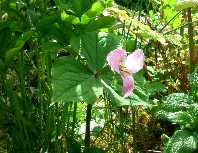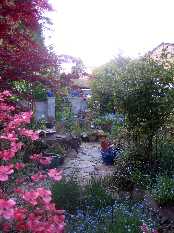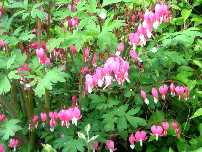
Dianne takes a journey through her garden
(#0001)

Trillilum (#0436)
 Spring Garden
Spring Garden
(#0512)
 Bleeding Hearts ©2005 (#0435)
Bleeding Hearts ©2005 (#0435) |
Travel In Your
Garden
1430 words
Take A Spring Tour In Your Own Backyard
by Dianne Roth
You can travel the world over, but there is no finer trip than the one you take through your garden in the spring. Put on your mucking-about boots, find your gloves, grab a four or five gallon plastic pot, and you are packed for the best little trip in town. It is free, it is nearby, and, with the right mindset, it is a magnificent excursion into the world at your fingertips.
The first stage of the journey is to step out the back door and let your senses go wild. Smell the deep brown of the earth. Listen to the birds and the nearly silent workings of the worms. Stick out your tongue and taste the air. My grandbabies taught me this trick. Move ever so slightly and your muscles awake to the possibilities before you.
From the top step, my eyes move over every inch of my small but abundant garden. I check the composition. Do I still like the overall construction? How is my pet tree doing? Where do I need more daffodils? What did I neglect to do in the fall? What did not survive the winter and needs replacing? Are the daphne beginning to perfume the air?
As I caress each nook and plant with my eyes, my mind remembers what was here 15 years ago. I mentally compare the neglected weed patch to the scene before me today. The aging arborvaeta has become a concrete block wall defining the boundries of my domain and adding a touch of southern France.
The dying Port Orford Cedars gave way to a stone courtyard that invites my guests to breathe deeply and enjoy moments of conversation or silence, imagining themselves in Mexico, Spain, or Italy.
The pile of broken patio concrete has become a deck for dancing or dining. Spirits from last year’s gatherings still whisper, making me eager for their return this summer. And, the bathtub plumbed with hot water, is calling me to a midsummer’s night soak.
The basic structure was the gift of a wonderful friend. She practiced garden design in my yard. The paper bark birches, mahogany cherry, the maples, and the evergreen magnolia were her ideas. The prairie flame crab apples were mine. For two weeks in the spring they are so stunning that people stop to ask about them. The euphorbias are beautiful, but not compatible with grandbabies. This might be their last year with me. And, I think I need more lavender. Every year I seem to need more lavender.
It took so much work. Each concrete block was placed by me. Each stone fitted together, each shovelful hefted and thrown, each plant nestled into the earth was my own toil and sweat. As I take this first step of my journey I relish each memory and begin exploring the possibilities of a new growing season.
Most of the plants in my garden were given to me before I knew better. “Here put this in your garden.” And, with no plan, I would. One of the more humorous plantings in my garden is the horizontal purple smoke tree. It was a three inch twig when it was given to me. To save it from a November freeze, I ran out, stuck it into the ground, and marked it with an imbedded stick. There it is today. Its rootball is no more than 18” from a magnificent red-leaf maple that was similarly thrown into the ground for its own good. The maple is vertical, but the smoke tree went horizontal to find enough sunshine.
Haphazard sometimes works. These two placed in proximity to a red dogwood are a stunning tableaux in the new green of spring. It is breathtaking to look up from dinner preparations to see the wonder of them and to laugh at the impossibility of it.
Farther from my house is an ancient cherry tree that was here long before I came. It was so big that you could see it from blocks away. It took three years to prune it down. Now I spend every winter trying to teach it to be a dwarf.
Another plant that was given to me as a small wisp of a thing was the larch. It was transplanted three times before it ended up in a whiskey barrel in my front yard. It stayed small until it figured out that it would only take one root, escaping through the bung hole, to end its stunted life. At 15 feet tall, it was brutally transported through the garage on various conveyances and given a new home in the back yard. With gentle caresses, encouraging words, rooting hormone, and daily watering, it made it through its first summer. It is thriving and you can tell it is a happy tree.
Unfortunately, its annual practical joke is missed by all my quests now. In early winter it loses its needles and looks miserably dead. I laugh and say, “No, it is not dead.” Friends give me the “poor thing” look and humor me. “Okay, Dianne. It’s not really dead.”
Early spring is the time to do the trillium census. Once, in a friend’s neighborhood, a bulldozer was preparing a native woodland for a housing development. My friend asked, “Do you want some trillium?” The choice was easy, dig or let them die. Of the 10 plants I rescued, nine return every year. Each spring, when they peek out of the ground, it is a thrilling reunion with old friends.
Spring is also the time to see the camas lily growing along the ditches of highway 99. Many years ago, a friend collected some seeds from his Tangent property and I tossed them about my yard. Two years ago, I found a strange looking lily in my front yard. I was tempted to hope it was a camas, but it opened white instead of blue. Last spring, during my spring garden trip, I found two more... blue! A stop along the highway confirmed my hopes. There is camas growing in my yard!
This year’s big garden surprise was the evergreen clematis. Planted beneath a copper trellis last spring, it did not put on any new growth through the entire summer. I came upon it with my eyes down, looking for signs of life in the geraniums at its feet. I smelled it before I saw it. Crisp, white, and so fragrant, it was the highlight of my spring garden travels.
After I have sufficiently savored my handiwork from a distance, it is time to go nose-to-nose with my garden. I grab my old pot and my gloves and wander the yard looking for my favorite weed. It is the small, circular one with the round leaves. By early spring it has sent up a stem in the center with very small white flowers. Soon after the flowers, small pea-like pods form. If they rippen, all it takes is a glancing blow and the pods burst open and spray the surrounding area with seeds. I call it the firecracker weed.
When I first moved here, firecrackers grew everywhere and I did not know how well designed they were for survival, but it took only a few seasons to begin to recognize their behavior. Because I search for one kind of weed at a time, my eye trains itself to find even the smallest ones. What used to take a whole day, now, because of my annual diligence, only takes a couple of hours. It is one of my more satisfying garden chores. But, it is more than just pulling up the firecracker weeds. It is moving slowly along, welcoming each bud, each new leaf, each chick-a-dee, each ladybug back into my garden. It is rejoicing that something returned and mourning when something did not. It is a time for plotting the future.
Much of this winter I have been gone on travels to faraway places. I have sketched ancient ruins in Mexico, collected vistas in northern California and North Carolina, visited family in the east and the west. My sketchbook is full of colors, textures, and memories from near and far. But, it is my annual spring walk through my garden that feeds my soul and keeps me planted in time and space. My garden vistas rival the ruins, each spring walk through my botanical community revitalizes me, and wandering through my garden allows me to remember the people and places that are precious to me, right here at home.
Dianne Roth is a teacher, mother, grandmother, and freelance
writer. She lives in Oregon.
|
|








